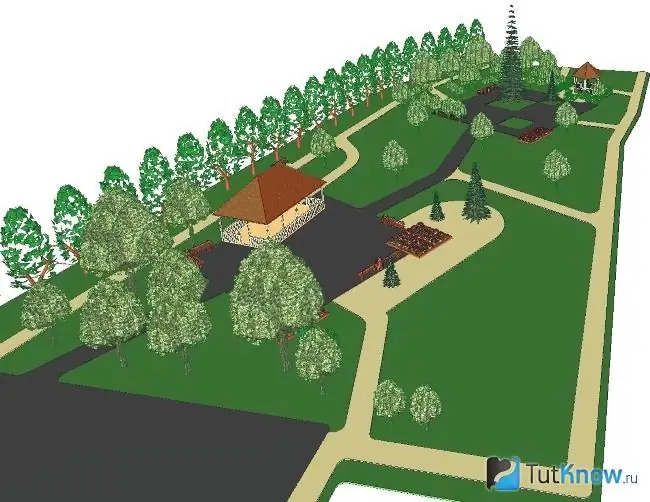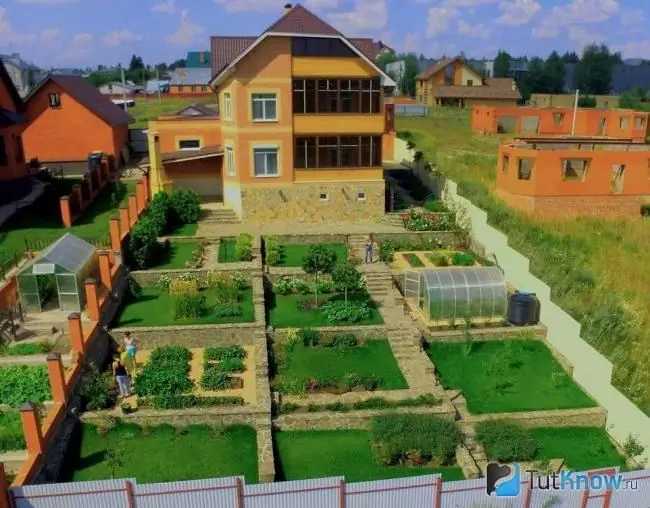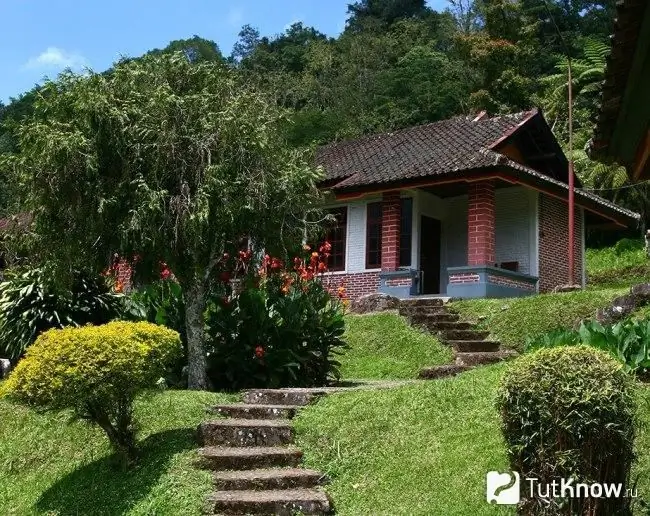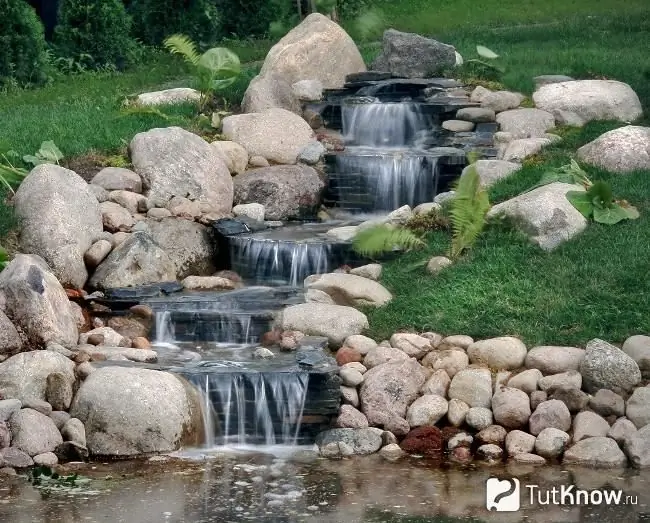- Author Arianna Cook [email protected].
- Public 2023-12-17 14:23.
- Last modified 2025-01-23 09:40.
Advantages and disadvantages of the site on the slope, the rules for planning the problem area, the placement of functional zones, the main techniques for improving the allotment. The planning of a plot with a slope is the arrangement of a non-standard landscape with a carefully played out height difference. This approach allows you to divide the allotment into functional zones and design it in an extraordinary way. How to properly tie sites with vegetation and buildings to non-standard terrain, you can learn from this article.
Advantages and disadvantages of a slope plot

Many people prefer to purchase only horizontal land plots for summer cottages, counting on their ease of use. However, allotments on the slopes provide more opportunities for the formation of an original appearance and the embodiment of non-standard ideas. Therefore, do not be upset if you have at your disposal a territory located at an angle to the horizon.
Its undoubted advantages include the following points:
- Slope summer cottages are always different from each other.
- Competent arrangement of the site will allow you to get a picturesque example of landscape art.
- Having placed the house at the very top, you can view the entire territory from the window.
- On such land, you can build design elements that are inaccessible to flat areas - an alpine slide, a waterfall or a cascade.
- If the slope is facing south, you can harvest a good harvest of fruits and vegetables on it due to the best sunlight.
Nevertheless, such allotments have quite a few disadvantages:
- It is difficult to grow a lawn on a steep slope.
- For the arrangement, significant financial investments will be required.
- It is necessary to water the plantings often, because water is poorly retained on the slope.
- Buildings are built only at the top, due to the danger of erosion of the foundation.
- Unstable areas can slide off.
- Moving over sloping terrain is exhausting.
- Young children should not play on steep slopes.
Creating a draft parcel with a slope

Landscaping begins with an analysis of various indicators, which will allow you to create an optimal layout of elements and develop a sequence of construction work.
The following characteristics should be assessed:
- Surface relief. The location of the zones (residential, recreation, garden), the placement of communications, etc. depends on it.
- Dimensions and geometry of the site. This characteristic influences the planning style.
- Possibilities of leveling the territory by means of terracing.
- Soil type. Often it is necessary to import fertile land for growing garden and horticultural crops.
- The depth of the groundwater table. Information is needed to create a drainage system for the removal of rain and flood water.
- Preferred wind direction. Ignoring this factor can lead to the death of green spaces, which do not take root well in very cold or very hot weather. It is necessary to select the appropriate plant varieties or provide protection from the winds.
- The location of the slope in relation to the cardinal points and the illumination of the territory. Characteristics have a large impact on crop yields. Plants should be selected correctly.
- Systems of measures to strengthen the soil on the slopes. These include planting vegetation with a branched root system that creates sod, mechanical strengthening of the soil, planting plants with powerful roots.
The result of the analysis of the information received is the creation of a project of a site with a slope, which must indicate:
- Houses and additional outbuildings (showers, gazebos, garage, etc.). The main object on the territory is the living quarters. The breakdown of the allotment begins with it.
- Rest zone. Accommodation depends on the decision of the owner of the dacha to concentrate entertainment places in one place or to scatter them throughout the dacha.
- Fencing fence. A hedge of 2-3 rows of trees or trimmed shrubs looks beautiful.
- Territory for a vegetable garden and a garden. Plots for them are prepared depending on the steepness of the slope.
- Terracing or other ways of leveling the surface. The resulting flat areas are used as lawns, pools are equipped in the hollows.
- Underground and overhead communications.
The optimal arrangement is considered to be such an arrangement of zones in which 9-11% of the territory is allocated for buildings, 65-77% for a garden and a vegetable garden, 11-16% for paths, stairs, access roads.
The plan is drawn up in a regular, landscape or mixed style. For a site at an angle, the landscape style is most suitable, in which the elements are located freely and naturally. Regular and symmetrical shapes are excluded, which adds to the attractiveness of the cottage. The regular style is designed for flat areas, and the mixed style combines the features of the first two.
The diagram is drawn at the selected scale, usually 1: 100. Divide the sheet into 1x1 cm squares, each corresponding to 1 m2 plot. Orient the sketch to the cardinal points. Cut out figures of buildings from cardboard to the same scale (apartment building, shower, garage, front garden, garden, etc.) and place them on the plan as you wish, taking into account building codes and other requirements. We recommend that you indicate the entrances and exits of buildings to avoid bitter disappointment. After receiving satisfactory results, you can start work on the improvement of the cottage.
Recommendations for arranging a site with a slope
The landscape of a plot with a slope is formed according to its own rules. Each zone is located depending on its purpose, size, terrain, etc. Often, the arrangement of the territory is influenced by the possibility of creating terraces - horizontal platforms that are easy to operate.
Terracing

Leveling is usually done on slopes greater than 15 degrees. With a slight slope, no surface modifications are made. In areas with a medium slope, you will need to build supports for the terrace. If the angle is very large, serious construction work using heavy equipment will be required. The number of platforms and their sizes depend on the angle of inclination. Ladders are used to move from one level to another.
Terracing begins with determining the steepness of the slope is carried out in several stages:
- Layout of horizontal sites … Their dimensions should be such that the elements of the site can be freely placed - a house, a flower bed, a vegetable garden. They can be arranged in a different sequence - in one row, in a checkerboard pattern, asymmetrically, it all depends on the wishes of the owner.
- Formation of horizontal platforms … The work starts from the top, gradually sinking to the base. The cut soil is moved to the lower areas. Usually, the height of the walls of the structure does not exceed 0.6-0.8 m, and the width is 4-5 m. On small allotments, 2-3 levels are equipped, on large ones - from 5 and more.
The terraces are supported by vertical walls. When erecting them, the following must be taken into account:
- Tilting and shearing forces act on the partitions, therefore the structure must withstand such loads. To increase the strength and durability of the walls, a foundation is needed, the dimensions of which depend on the size of the partition, as well as on the characteristics of the soil.
- In order for the support to withstand large vertical loads, a drainage system is created that prevents the foundation from being washed away by water.
- When building with a "dry" method, sprinkle the stones with soil and seeds. After a short period of time, the wall will look very beautiful. But without cement mortar, the protective structure does not resist well the large amount of water that appears on the site during rain or melting snow.
- Brick walls are very beautiful and durable. Partitions can be made deaf, discharged, winding or zigzag, etc.
- Wooden structures look very nice, but their service life is short, even after treatment with special preparations.
- Concrete walls can be built up to 3 m high, which is much more than stone or brick (0.8 m). It is allowed to use ready-made panels or fill in the formwork.
Residential and auxiliary buildings

It is difficult to erect buildings on sloping areas. This requires a large amount of work to be done on the basement and underground parts of the building. Ideally, the building should protect the area from the prevailing winds and not shade green spaces.
When building, use our recommendations:
- Place buildings so that there is the shortest distance between them.
- It is recommended to build houses in the north or northwest of the allotment.
- If the site is deployed to the south, build the house at the very top. If to the east and west - also above all the elements of the cottage, at its northern border.
- If the territory descends to the north, erect the building in the middle of the allotment, closer to the west side.
- In any case, do not build a house at the bottom of the slope to avoid flooding. The facade of the building must face the street.
- Often 5-7 m of free space is left between the building and the road, which is filled with flowers and low bushes.
- The location of the windows is important. Openings facing south-east and south-west provide room lighting throughout the day, while north-facing openings create shading that cools the room in hot weather.
- The size of the shadow cast by the house can be used to determine the geometry of the recreation area and the car park.
- The gazebo is usually located in the most beautiful place with a good view. The playground is located on the lawn under the windows of the room, where adults most often gather in the daytime. A bod barbecue is left on the edge.
There are several techniques for building a house on a slope. The horizontal structure of the building is ensured by the high base, in which case the natural slope is preserved. The basement can accommodate a garage, shed, kitchen. The place for the building is leveled by filling or cutting.
Green areas

On sloping terrain, plantings look especially beautiful.
Plants are planted according to certain rules:
- Vegetables and fruits are grown on the sunny side, where they take root well.
- Do not plant trees closer than 5 m from buildings so that they do not have dampness from lack of light.
- On the north side of the building, plant spreading fruit trees - apple trees, pears. You can also place an apple and cherry tree on the east side of the building. In this case, in the summer there will be a large shaded area near the house.
- Plant shrubs near your garage and around compost heaps and other unsightly areas.
- On the south side of the house, plant heat-loving plants - grapes.
- Grow vegetables in the middle of the area, where there is no shade. Provide the same conditions for the flower garden.
- Avoid tall shrubs around the edges of the garden, it gives a long shadow. You can grow raspberries on the southern side of the garden, it almost does not give a shadow.
Creation of a drainage system

On the layout of a site with a slope, a drainage scheme must be indicated, which is necessary to maintain a constant water balance and quickly remove rainwater and moisture that appears in spring during snow melting. The danger from excess moisture is the formation of gullies.
The steeper the angle of inclination, the faster the water will wash it away. Even small streams wash out deep gullies over time, which leads to the formation of deep ravines. The arrangement of gutters begins after the completion of the construction of the main buildings, communications, green plantings.
The drain can be open or closed. The latter option has an advantage, since saves usable space. Access roads and paths can be arranged above them.
The drainage system is a system of trenches and receiving collectors. Highways are digging along the slope. The most effective option is considered to be in which the ditches are arranged in the form of a "herringbone". In this case, additional taps are adjacent to the central trench, which removes moisture outside the site or to a receiving manifold.
The depth of the trenches is 0.3-1 meters. The bottom should have a slope of at least 2 mm over a length of 1 m. Fill it with sand with a layer of 10 cm, then cover it with geotextiles with an overlap on the walls. Pour crushed stone on top with a layer of 15-20 cm.
Place the pieces of perforated drainage pipe on the prepared pillow and connect them together. Fill the pipe with rubble and cover with geotextile. Fill the remaining space with sand or soil.
Plot decoration

The multilevel arrangement of individual sections allows you to introduce original ideas. A good option for a non-standard area is the Alpine style with a lot of rough stones and bright colors.
Using these elements, you can solve the following tasks:
- Zone decoration;
- Strengthening the soil with boulders;
- Snow retention;
- Site decoration.
On an inclined allotment, plants are planted according to certain rules: the higher the place, the lower the plants. At the top there should be undersized species, at the base - trees and tall bushes, which allows you to visually align the allotment.
There should be no free fields at the dacha. Fill the strips with lawn or ground cover plants to prevent soil washout. A lawn can be grown on a sloping slope.
Track arrangement

To move around the site, consider the location of the paths.
The following requirements are imposed on them:
- The width of the tracks and the height of the steps throughout the area must be the same to avoid injury when going up and down. To smooth out the elevation differences of the tracks, make them winding.
- The maximum angle of the path is 45 degrees. With these parameters, be sure to make a railing. Make the steps 25-30 cm wide, the risers 15 cm high.
- With a large slope of the land plot on the stairs, be sure to provide rest areas, after which the direction of movement should change.
- The most affordable is a wooden staircase. In this case, the riser is made of boards fixed with pegs on the sides, and the tread is formed by compacted soil.
- More durable will be a staircase made of brick, stone or concrete. In the latter case, use formwork.
- A section of ladder with 10 steps or more should rest on a concrete base to prevent it from slipping.
- The dimensions and shape of the stairs depend on the functional purpose of the site and do not necessarily correspond to accepted standards.
Strengthening the slopes

To prevent the soil from slipping, the soil must be strengthened. For this, the following methods are used:
- Natural fortifications … They are used at small angles (up to 15 degrees). It is recommended to plant areas on the slopes with creeping plants, near the base - lilacs, rose hips, willow. The roots of these plants intertwine and form a strong frame.
- Use of geomaterials - geotextiles or geogrids … The material is laid on the surface and covered with soil. After a short period of time, a layer of sod and other vegetation appears, which reliably prevent the soil from slipping. The service life of the geomaterial is over 50 years.
- Embankment … This is the creation of barriers from soil, which is taken from the sole and poured on top of the slope. Used in large areas, because takes up a lot of usable space. Periodically, soil must be poured to increase the height of the embankment.
- Retaining walls made of wood or stone … They not only strengthen the slopes, but also create comfortable terracing. Most often this method is used in hilly terrain with any height difference. Partitions up to 0.8 m are easy to build yourself. Massive walls that can withstand heavy loads are built using heavy machinery.
- Gabions … These are special factory-made structures filled with pebbles, stones and other materials. If the contents are sprinkled with earth, in the spring overgrowth will appear above the structure, which will mask it.
Watch a video about a plot with a slope:

A suburban area, which is not very attractive at first, located at an angle to the horizon, with the right approach, will become a beautiful and comfortable recreation area. To obtain a good result, it is necessary to study the features of using the problem area, which should be taken into account even at the stage of developing a project for arranging a summer cottage.






